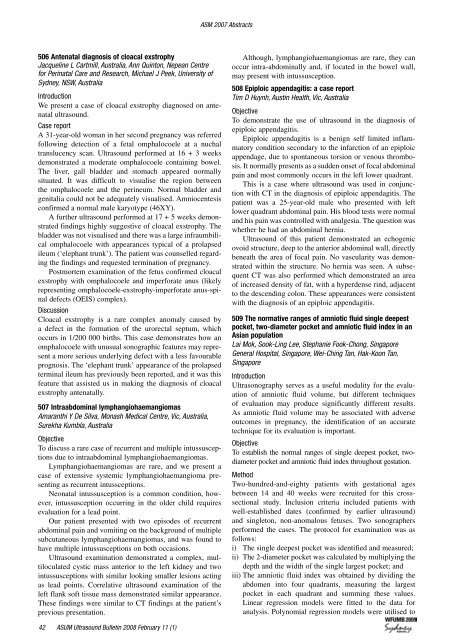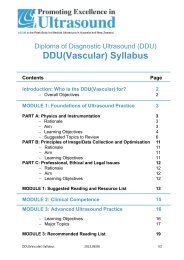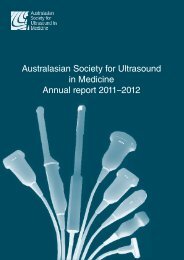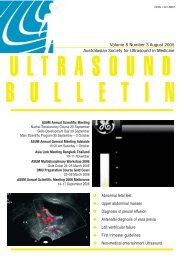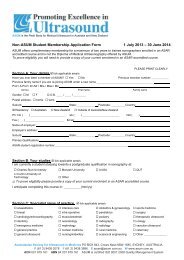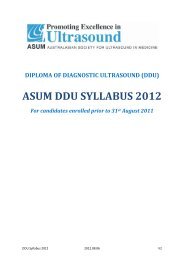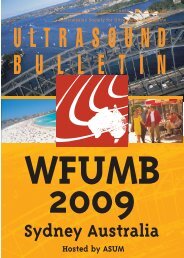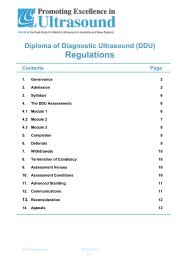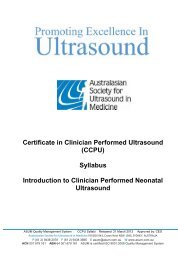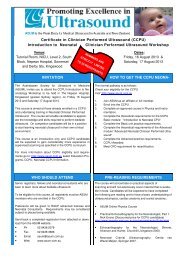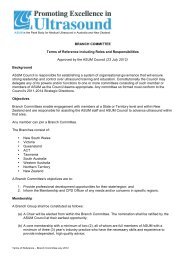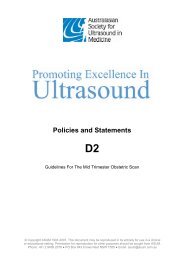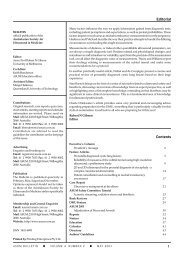Volume 11 Issue 1 (February) - Australasian Society for Ultrasound ...
Volume 11 Issue 1 (February) - Australasian Society for Ultrasound ...
Volume 11 Issue 1 (February) - Australasian Society for Ultrasound ...
You also want an ePaper? Increase the reach of your titles
YUMPU automatically turns print PDFs into web optimized ePapers that Google loves.
ASM 2007 Abstracts<br />
506 Antenatal diagnosis of cloacal exstrophy<br />
Jacqueline L Cartmill, Australia, Ann Quinton, Nepean Centre<br />
<strong>for</strong> Perinatal Care and Research, Michael J Peek, University of<br />
Sydney, NSW, Australia<br />
Introduction<br />
We present a case of cloacal exstrophy diagnosed on antenatal<br />
ultrasound.<br />
Case report<br />
A 31-year-old woman in her second pregnancy was referred<br />
following detection of a fetal omphalocoele at a nuchal<br />
translucency scan. <strong>Ultrasound</strong> per<strong>for</strong>med at 16 + 3 weeks<br />
demonstrated a moderate omphalocoele containing bowel.<br />
The liver, gall bladder and stomach appeared normally<br />
situated. It was difficult to visualise the region between<br />
the omphalocoele and the perineum. Normal bladder and<br />
genitalia could not be adequately visualised. Amniocentesis<br />
confirmed a normal male karyotype (46XY).<br />
A further ultrasound per<strong>for</strong>med at 17 + 5 weeks demonstrated<br />
findings highly suggestive of cloacal exstrophy. The<br />
bladder was not visualised and there was a large infraumbilical<br />
omphalocoele with appearances typical of a prolapsed<br />
ileum (‘elephant trunk’). The patient was counselled regarding<br />
the findings and requested termination of pregnancy.<br />
Postmortem examination of the fetus confirmed cloacal<br />
exstrophy with omphalocoele and imper<strong>for</strong>ate anus (likely<br />
representing omphalocoele-exstrophy-imper<strong>for</strong>ate anus-spinal<br />
defects (OEIS) complex).<br />
Discussion<br />
Cloacal exstrophy is a rare complex anomaly caused by<br />
a defect in the <strong>for</strong>mation of the urorectal septum, which<br />
occurs in 1/200 000 births. This case demonstrates how an<br />
omphalocoele with unusual sonographic features may represent<br />
a more serious underlying defect with a less favourable<br />
prognosis. The ‘elephant trunk’ appearance of the prolapsed<br />
terminal ileum has previously been reported, and it was this<br />
feature that assisted us in making the diagnosis of cloacal<br />
exstrophy antenatally.<br />
507 Intraabdominal lymphangiohaemangiomas<br />
Amaranthi Y De Silva, Monash Medical Centre, Vic, Australia,<br />
Surekha Kumbla, Australia<br />
Objective<br />
To discuss a rare case of recurrent and multiple intussusceptions<br />
due to intraabdominal lymphangiohaemangiomas.<br />
Lymphangiohaemangiomas are rare, and we present a<br />
case of extensive systemic lymphangiohaemangioma presenting<br />
as recurrent intussceptions.<br />
Neonatal intussusception is a common condition, however,<br />
intussusception occurring in the older child requires<br />
evaluation <strong>for</strong> a lead point.<br />
Our patient presented with two episodes of recurrent<br />
abdominal pain and vomiting on the background of multiple<br />
subcutaneous lymphangiohaemangiomas, and was found to<br />
have multiple intussusceptions on both occasions.<br />
<strong>Ultrasound</strong> examination demonstrated a complex, multiloculated<br />
cystic mass anterior to the left kidney and two<br />
intussusceptions with similar looking smaller lesions acting<br />
as lead points. Correlative ultrasound examination of the<br />
left flank soft tissue mass demonstrated similar appearance.<br />
These findings were similar to CT findings at the patient’s<br />
previous presentation.<br />
Although, lymphangiohaemangiomas are rare, they can<br />
occur intra-abdominally and, if located in the bowel wall,<br />
may present with intussusception.<br />
508 Epiploic appendagitis: a case report<br />
Tim D Huynh, Austin Health, Vic, Australia<br />
Objective<br />
To demonstrate the use of ultrasound in the diagnosis of<br />
epiploic appendagitis.<br />
Epiploic appendagitis is a benign self limited inflammatory<br />
condition secondary to the infarction of an epiploic<br />
appendage, due to spontaneous torsion or venous thrombosis.<br />
It normally presents as a sudden onset of focal abdominal<br />
pain and most commonly occurs in the left lower quadrant.<br />
This is a case where ultrasound was used in conjunction<br />
with CT in the diagnosis of epiploic appendagitis. The<br />
patient was a 25-year-old male who presented with left<br />
lower quadrant abdominal pain. His blood tests were normal<br />
and his pain was controlled with analgesia. The question was<br />
whether he had an abdominal hernia.<br />
<strong>Ultrasound</strong> of this patient demonstrated an echogenic<br />
ovoid structure, deep to the anterior abdominal wall, directly<br />
beneath the area of focal pain. No vascularity was demonstrated<br />
within the structure. No hernia was seen. A subsequent<br />
CT was also per<strong>for</strong>med which demonstrated an area<br />
of increased density of fat, with a hyperdense rind, adjacent<br />
to the descending colon. These appearances were consistent<br />
with the diagnosis of an epiploic appendagitis.<br />
509 The normative ranges of amniotic fluid single deepest<br />
pocket, two-diameter pocket and amniotic fluid index in an<br />
Asian population<br />
Lai Mok, Sook-Ling Lee, Stephanie Fook-Chong, Singapore<br />
General Hospital, Singapore, Wei-Ching Tan, Hak-Koon Tan,<br />
Singapore<br />
Introduction<br />
Ultrasonography serves as a useful modality <strong>for</strong> the evaluation<br />
of amniotic fluid volume, but different techniques<br />
of evaluation may produce significantly different results.<br />
As amniotic fluid volume may be associated with adverse<br />
outcomes in pregnancy, the identification of an accurate<br />
technique <strong>for</strong> its evaluation is important.<br />
Objective<br />
To establish the normal ranges of single deepest pocket, twodiameter<br />
pocket and amniotic fluid index throughout gestation.<br />
Method<br />
Two-hundred-and-eighty patients with gestational ages<br />
between 14 and 40 weeks were recruited <strong>for</strong> this crosssectional<br />
study. Inclusion criteria included patients with<br />
well-established dates (confirmed by earlier ultrasound)<br />
and singleton, non-anomalous fetuses. Two sonographers<br />
per<strong>for</strong>med the cases. The protocol <strong>for</strong> examination was as<br />
follows:<br />
i) The single deepest pocket was identified and measured;<br />
ii) The 2-diameter pocket was calculated by multiplying the<br />
depth and the width of the single largest pocket; and<br />
iii) The amniotic fluid index was obtained by dividing the<br />
abdomen into four quadrants, measuring the largest<br />
pocket in each quadrant and summing these values.<br />
Linear regression models were fitted to the data <strong>for</strong><br />
analysis. Polynomial regression models were utilised to<br />
42 ASUM <strong>Ultrasound</strong> Bulletin 2008 <strong>February</strong> <strong>11</strong> (1)


